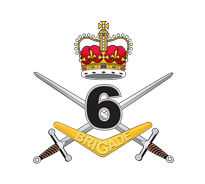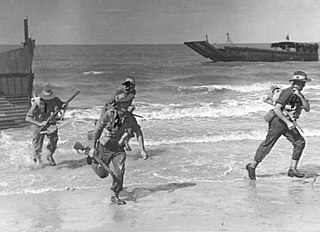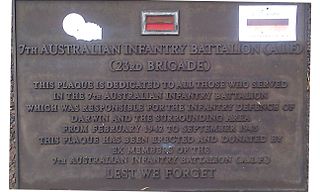
The 7th Division was an infantry division of the Australian Army. It was formed in February 1940 to serve in World War II, as part of the Second Australian Imperial Force. The division was raised on the British establishment of nine infantry battalions per division and consisted of two new brigades and three of the original 12 battalions of the 6th Division forming the third brigade. The division is sometimes known by the nickname "The Silent Seventh", due to a perception that its achievements were unrecognised, in comparison to the other Australian divisions. The origin of this belief appears to be censorship of the part played by the 7th Division in the fierce fighting in the 1941 Syria-Lebanon campaign. The 7th Division along with the 6th and 9th Australian Divisions were the only divisions to serve in both the Middle East and the South West Pacific Area. It was disbanded in 1946, following the end of the war.

The Borneo campaign or Second Battle of Borneo was the last major Allied campaign in the South West Pacific Area during World War II to liberate Japanese-held British Borneo and Dutch Borneo. Designated collectively as Operation Oboe, a series of amphibious assaults between 1 May and 21 July 1945 were conducted by the Australian I Corps, under Lieutenant-General Leslie Morshead, against Imperial Japanese forces who had been occupying the island since late 1941 – early 1942. The main Japanese formation on the island was the Thirty-Seventh Army under Lieutenant-General Masao Baba, while the naval garrison was commanded by Vice-Admiral Michiaki Kamada. The Australian ground forces were supported by US and other Allied air and naval forces, with the US providing the bulk of the shipping and logistic support necessary to conduct the operation. The campaign was initially planned to involve six stages, but eventually landings were undertaken at four locations: Tarakan, Labuan, North Borneo and Balikpapan. Guerilla operations were also carried out by Dayak tribesmen and small numbers of Allied personnel in the interior of the island. While major combat operations were concluded by mid-July, localised fighting continued throughout Borneo until the end of the war in August. Initially intended to secure vital airfields and port facilities to support future operations, preparatory bombardment resulted in heavy damage to the island's infrastructure, including its oil production facilities. As a result, the strategic benefits the Allies gained from the campaign were negligible.

The Battle of Tarakan was the first stage in the Borneo campaign of 1945. It began with an amphibious landing by Allied forces on 1 May, code-named Operation Oboe One; the Allied ground forces were drawn mainly from the Australian 26th Brigade, but included a small element of Netherlands East Indies personnel. The main objective of the landing was the capture of the island's airfield. While the battle ended with success for the Allied forces over the Japanese defenders, this victory is generally regarded as having not justified its costs. The airfield was so heavily damaged that it ultimately could not be repaired in time to make it operational for other phases of the Allied campaign in Borneo.

The Battle of Balikpapan was the concluding stage of Operation Oboe, the campaign to liberate Japanese-held British and Dutch Borneo. The landings took place on 1 July 1945. The Australian 7th Division, composed of the 18th, 21st and 25th Infantry Brigades, with a small number of Netherlands East Indies KNIL troops, made an amphibious landing, codenamed Operation Oboe Two, a few miles north of Balikpapan. The Allied invasion fleet consisted of around 100 ships. The landing had been preceded by heavy bombing and shelling by Australian and US air and naval forces. The Allied force totalled 33,000 personnel and was commanded by Major General Edward Milford, while the Japanese force, commanded by Rear Admiral Michiaki Kamada, numbered between 8,400 and 10,000, of which between 3,100 and 3,900 were combatants. After the initial landing, the Allies secured the town and its port, and then advanced along the coast and into the hinterland, capturing the two Japanese airfields. Major combat operations concluded around 21 July, but were followed by mopping-up operations, which lasted until the end of the war in mid-August. Australian troops remained in the area until early 1946.

III Corps was an Australian Army unit during World War II. It was responsible for the defence of Western Australia in 1942–1944. The corps was formed in April 1942 from Western Command, which had been established in October 1939. Throughout the war, the formation's size expanded and contracted as available manpower, and the strategic situation, dictated. At its height, the corps consisted of two infantry divisions and one armoured division, which were deployed to defend against a Japanese invasion threat, which ultimately never eventuated. The corps ceased to exist in June 1944 when it was converted back into Western Command, which remained until the end of the war in 1945.

I Corps was an Australian Army corps, one of three that were raised by the Army during World War II. It was the main Australian operational corps for much of the war. Various Australian and other Allied divisions came under its control at different times. In 1940–1942, the corps was based in the Mediterranean and Middle Eastern theatres, and controlled forces in action against the Germans, Italians and later the Vichy French in North Africa, Greece and Syria–Lebanon.

The Battle of Labuan was an engagement fought between Allied and Imperial Japanese forces on the island of Labuan off Borneo during June 1945. It formed part of the Australian invasion of North Borneo, and was initiated by the Allied forces as part of a plan to capture the Brunei Bay area and develop it into a base to support future offensives.
The Newcastle Covering Force was an Australian militia force responsible for protecting the strategically important Newcastle region in New South Wales and its approaches during World War II. Established on 8 April 1941, the formation's composition changed over the course of its existence, starting from a single infantry battalion support by a machine-gun unit and swelling to roughly brigade-size, with a brigade headquarters and three battalions – two infantry and one garrison – supported initially by a machine gun battalion that was later converted to a motor regiment. The unit was responsible for defending the important port and air bases in and around the town, part of Fortress Newcastle, against a feared Japanese invasion. Newcastle Covering Force was converted on 15 April 1942 to the 10th Division, a regular Australian Army unit, following a complete re-organisation of the higher command structures of the Australian Army.

The 2/9th Battalion was an infantry battalion of the Australian Army during World War II. Raised in Queensland as part of the Second Australian Imperial Force shortly after the outbreak of the war, it formed part of the 18th Brigade and over the course of the war it was attached to the 6th, 9th and 7th Divisions due to several re-organisations. It served in the United Kingdom in 1940, forming part of a small Australian garrison sent there to help defend against a possible German invasion, before being transferred to North Africa where it took part in the Siege of Tobruk and then undertook garrison duties in Syria following the Syria–Lebanon campaign in 1941.

The 6th Combat Support Brigade is an Australian Army brigade. First formed in 1912 as a Militia formation to provide training under the compulsory training scheme, the brigade was re-raised during the First World War as an infantry unit of the all volunteer Australian Imperial Force. It subsequently served at Gallipoli and in France and Belgium on the Western Front. In the 1920s, as part of a reorganisation of the Australian Army, it became part of the 3rd Military District of the Citizens Military Force, encompassing units from Victoria and South Australia. In 1991, it became part of the Ready Reserve Scheme, based at Enoggera Barracks, in Brisbane, Queensland, before being disbanded in 1996 when the scheme was discontinued. The brigade was re-raised on 1 March 2010 to oversee the Army's command support and intelligence, surveillance, target acquisition and reconnaissance units.

The 2nd Health Brigade (2HB) is an Australian Army brigade. The 2nd Brigade was formed in 1903 as a militia infantry formation based in Victoria, the brigade later served during the First World War as part of the Australian Imperial Force, allocated to the 1st Division. During the war, the 2nd Brigade took part in the fighting at Gallipoli, including the Battle of Krithia where it lost almost a third of its strength. Later they took part in the Battle of Lone Pine before being withdrawn back to Egypt in December 1915. Following this the brigade was transferred to the Western Front in France and Belgium where, between March 1916 and the armistice in November 1918, they took part in most of the major Allied operations.

The 14th Brigade was an infantry brigade of the Australian Army. Originally raised in 1912 as a Militia formation, it was later re-raised in 1916 as part of the First Australian Imperial Force for service during World War I, the brigade was assigned to the 5th Division and served on the Western Front between 1916 and 1918 before being disbanded. It was later re-raised as part of the Australia's part-time military forces during the inter-war years. During World War II, the brigade was a Militia formation and it took part briefly in the New Guinea campaign with elements of the brigade undertaking defensive duties around Port Moresby before taking part in the fighting along the Kokoda Track and around the Japanese beachheads at Buna–Gona. The brigade was disbanded in mid-1943 as part of a rationalisation of Australian military forces as a result of manpower shortages.

The 24th Brigade was a brigade-sized infantry unit of the Australian Army. Formed on 1 July 1940 as part of the Second Australian Imperial Force, the unit was raised for service during World War II. Originally formed as part of the 8th Australian Division the brigade was subsequently transferred to the newly created 9th Australian Division in December. The brigade served during the Western Desert Campaign, forming part of the Allied garrison during the Siege of Tobruk. Later, the brigade was withdrawn to Syria for occupation duties, but then later took part in the First and Second Battles of El Alamein. In early 1943, the brigade was returned to Australia to fight against the Japanese in the Pacific. In 1943–1944, the brigade fought in New Guinea, taking part in the landing at Lae and the Huon Peninsula campaign. Its final campaign came late in the war, when it took part in the Labuan landings and the Battle of North Borneo in mid-1945. After the war, the brigade was disbanded in early 1946.

The 23rd Brigade was a brigade of the Australian Army. It was briefly raised in 1912 as a Militia formation providing training as part of the compulsory training scheme. Later, it was re-formed in July 1940 for service during the Second World War, the brigade was initially a formation of the Second Australian Imperial Force assigned to the 8th Division; however, after its sub units were captured by the Japanese in 1942 it was reformed with Militia battalions and was mainly used in a garrison role around Darwin, in the Northern Territory, until late in the war when it was committed to the fighting against the Japanese on Bougainville. It was disbanded in 1946.

The 29th/46th Battalion was an infantry battalion of the Australian Army. It was formed in August 1942 by the amalgamation of two previously existing Militia battalions, the 29th and 46th, which were merged following a decision by the Australian government to release manpower from the military back into industry to meet the nation's increased production requirements. Initially the 29th/46th, serving as part of the 4th Brigade, undertook garrison duties in Australia, however, in 1943 the battalion was deployed to New Guinea where it garrisoned Milne Bay before subsequently taking part in the Huon Peninsula campaign in support of the 9th Division. In late 1944, after being deployed for over a year and a half, the battalion returned to Australia for a brief period of leave and reorganisation. In early 1945, however, they were again deployed overseas, this time to the island of New Britain where they undertook a campaign to contain the large Japanese garrison. Following the end of the war the battalion was disbanded in June 1946.
The 2/3rd Pioneer Battalion was a pioneer battalion of the Australian Army, which served during World War II. Formed in 1940, the battalion served in the Middle East where it fought in Syria and Palestine before taking part in the fighting around El Alamein. In 1943, the battalion returned to Australia and subsequently took part in the fighting against the Japanese in New Guinea in 1943–1944. Their final campaign came in mid-1945, when they took part in the Battle of Tarakan during the Borneo campaign. The battalion was disbanded in early 1946.

The 2/33rd Battalion was an infantry battalion of the Australian Army during the Second World War. It was formed as part of the Second Australian Imperial Force in the United Kingdom in June 1940 as the "72nd Battalion" to create the 25th Brigade, which eventually became part of the 7th Division. After the threat of invasion had passed, the battalion was transferred to the Middle East in early 1941, and after a period of garrison duty in the Western Desert, the battalion fought against the Vichy French in the invasion of Syria and Lebanon.

The 2/2nd Machine Gun Battalion was an infantry support unit of the all-volunteer Second Australian Imperial Force that was raised for service overseas during the Second World War. Formed in mid-1940 in Sydney, from personnel drawn from the states of Queensland and New South Wales, the battalion was allocated to the Australian 9th Division. After completing training in Australia, the battalion operated in the Middle East between early 1941 and early 1943, seeing action against German and Italian forces at the First and Second Battles of El Alamein, and undertaking garrison duties in Syria as part of the Allied garrison that was established there after the Syria–Lebanon campaign.

The 2/1st Pioneer Battalion was a pioneer battalion of the Australian Army during World War II. Raised in early 1940, the battalion served throughout the war, seeing action in North Africa, particularly around Tobruk in 1941, before being brought back to Australia in 1942. It later took part in the fighting against the Japanese in New Guinea in 1942–43, and then in Borneo in 1945. It was disbanded in early 1946. The battalion undertook both infantry and engineer tasks.
The 2/2nd Pioneer Battalion was one of four pioneer battalions raised as part of the Second Australian Imperial Force during World War II. Raised in 1940, the battalion served in the Middle East during the Syria–Lebanon Campaign against the Vichy French in mid-1941, fighting mainly as infantry. In 1942, the battalion was committed to the defence of Java, fighting against the Japanese and was all but destroyed following the capitulation of the defending garrison. Rebuilt in 1943, it later took part in the Salamaua–Lae and Finisterre Range campaigns in 1943–44 and the Borneo campaign in 1945 before being disbanded.


















